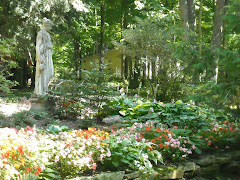“Until man duplicates a blade of grass, nature can laugh at his so
called scientific knowledge.”
- Thomas Edison
Last week we challenged conventional thinking with an organic approach to feeding our lawns and gardens. I had no idea that after submitting my article, that later that afternoon I would meet a gentleman named Arnie, who is a field rep for Specialty Turf. Arnie is a walking seminar on organics, biology, crop science, and some stuff that made my brain itch. I guess my point is that you never stop learning, and I feel better informed this week than the last. I would like to pick up from where we left off last week and talk a little about the important fundamentals of developing and maintaining a healthy and beautiful lawn.
Let’s start with preparation. The majority of turf problems begin here. If you are planning on installing a new lawn, make sure that you have at the very minimum 4” to a preferred 8” of good humic topsoil. This allows strong root development and moisture retention. Typically this is an area where I see landscape clients try to cut back on to save money. …Bad idea. Inadequate topsoil amounts open the door to thin and patchy turf, requiring excessive amounts of water and chemicals. And, over time costing you more in dollars and frustration.
Next you will be facing an important decision; “To irrigate or not to irrigate…That is the question”. I was speaking with Wally Skic of Green Lawn Sprinkler Systems, and he told me that “the installation price of a basic irrigation system for a city lot runs between 3,000.00 to 3,800.00.” All things considered, this is a bargain! When seeding a new lawn, you will need to keep the area damp through the germination process then watering heavier until you have established turf. Skic said; “Water until you get the desired color… (Nice and green), then back off until you see a bit of a change”. “You need to experiment a little, because it all depends on the amount and type of topsoil under your turf”. “For thinner topsoil 4” or less, you will want about 1/3 of an inch of water about every other day – For ideal topsoil depths of approximately 8 inches… 1/2 inch of water twice a week will produce a lush and beautiful lawn”.
OK, it’s TOOL TIME… We are heading for the land of facial hair and Adam’s Apples. It’s time to talk about maintaining that patch of paradise. Now that we have cultivated our green pride and joy, we need to think about some crucial aspects of turf maintenance… Let’s talk mowers.. “Ehh, Ehh, Ehh”. Yes there is a definite “thing” that a lot of us have with our riding mowers. We head out to the garage on a Saturday morning and fire up the John Deere and ride off into battle. We take pride in our lawns and at times invest heavily in them. We seek a neat, groomed appearance, but often times our approach works against our desired outcome. Cutting with dull blades and “scalping” or cutting too short are two of the more common mistakes. “Short Cutting” retards root development, requires more water, and invites weed invasion – especially annual weeds such as Crab Grass. We should maintain a height of 2 to 3 inches for the common types of turf in our area (Fescues and Bluegrass) and observe the “one-third rule” (Never removing more than one third of the leaf area per mowing”. Following proper installation and maintenance guidelines will give you the results you are looking for. Information is available on line or the Public Library on best practice turf techniques, or, consult an industry professional. The results are worth the investment!
“The grass may be greener on the other side of the fence, but you still have to mow it.”
- Anonymous
James Merritt/ Landscape Designer
www.livingcolorlandscapes.net
Thursday, June 25, 2009
Subscribe to:
Post Comments (Atom)






1 comment:
I saw you on the news! I'm glad to know a "moviestar"
Take care :-)
Post a Comment